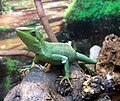| Laemanctus | |
|---|---|
 | |
| Laemanctus longipes, eastern casquehead iguana | |
| Scientific classification | |
| Kingdom: | Animalia |
| Phylum: | Chordata |
| Class: | Reptilia |
| Order: | Squamata |
| Suborder: | Iguania |
| Family: | Corytophanidae |
| Genus: | Laemanctus Wiegmann, 1834 |
| Species | |
4, see text. | |
Laemanctus is a genus of lizards in the family Corytophanidae. Species in the genus Laemanctus are commonly referred to as conehead lizards or casquehead iguanas. The genus is endemic to Central America. [1]


